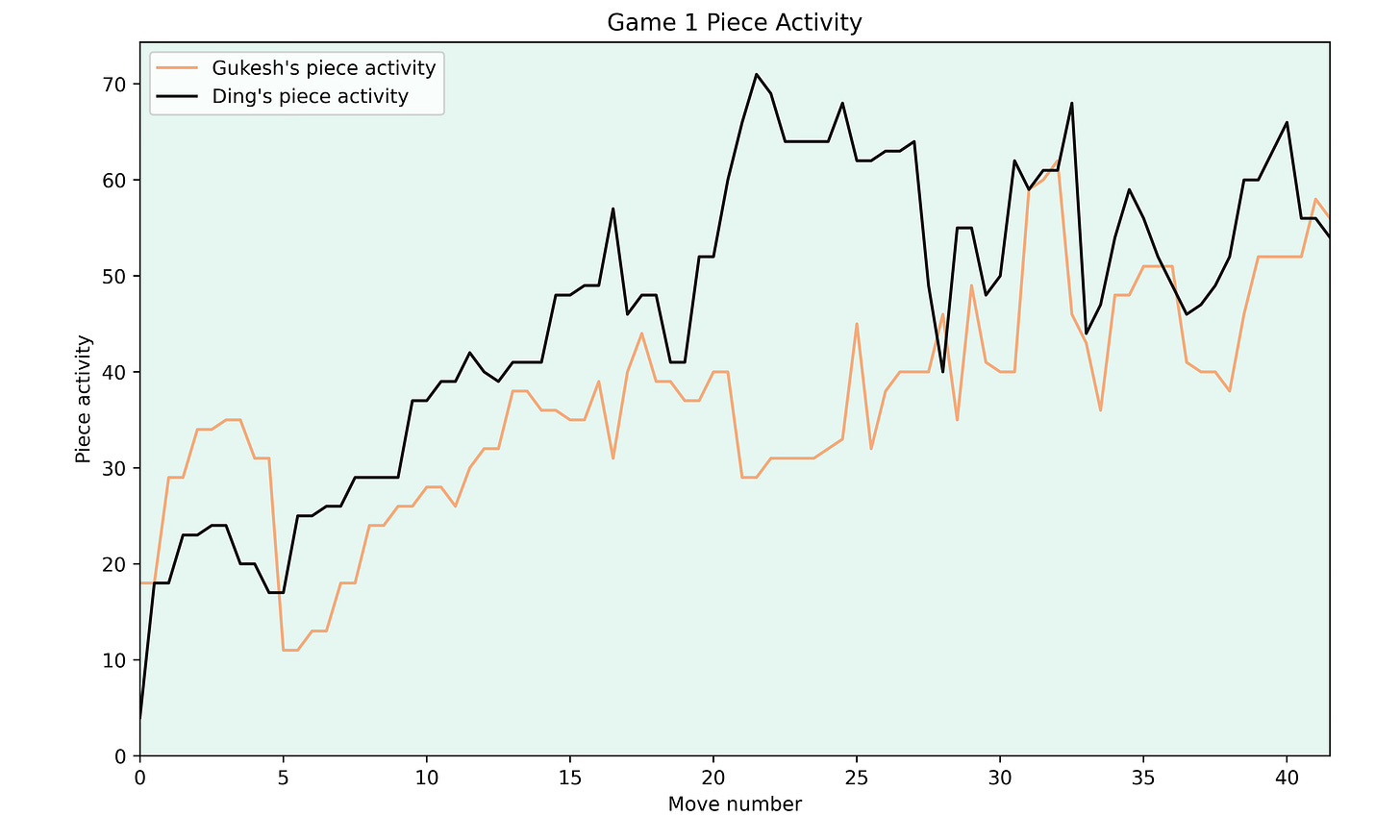Engine Analysis of Games 1-3 from the World Championship
What can engines tell us about the first three games?
Now that the first 3 games of the world chess championship match between Ding and Gukesh have been played, I want to dive a bit deeper into the games and look at them with the help of engines.
I highly recommend to also check out the annotations by GM David Navara on Lichess to get a more traditional analysis of the games.
Game 1
The first game was already very exciting and this can also be seen in the win, draw and loss probabilities calculated by LC0 for both players over the course of the game:
Around move 20 Ding started to gain the upper hand. He played a bit inaccurately with 27…fxe6 but Gukesh missed his chance.
It's interesting to see that this is also reflected in the piece activity for both players:
Ding's piece activity increases a lot around move 20 and suddenly drops when he gave up a big part of his advantage..
Looking at the sharpness in the position and how it changed after each move by the players gives some additional insights.
There is a big spike at move 10 for White which was the move where Gukesh played 10.g4. After that big increase in sharpness, the game stays sharp and the sharpness only drops after Gukesh missed his chance to make the game more complicated on move 30.
Another important factor in game 1 was the time usage.
Ding spent a lot of time early on and was already low on after 15 moves. But then he started to play very quickly. While Ding spent hardly any time between moves 15 and 25, Gukesh went from having over 80 minutes on his clock to under 20 minutes. The clock might have been played a role in Gukesh missing his chance at move 30.
Game 2
After Ding’s opening win, the second game was much calmer. This can also be seen in all the graphs I generated for the game.
The WDL didn’t change much during the game, but Ding kept a small advantage as White until the end, so it might have made sense to play on and try to push. But that’s of course easier said than done since Gukesh would certainly have defended well.
The piece activity also remains somewhat tame but Gukesh was slightly more active (according to my metric) in the end due to the knight on d4.
As you can probably imagine, the sharpness for this game isn’t too interesting either.
I was surprised by the spike caused by Ding’s 9.a5 but the sharpness came down quickly after Gukesh castled.
The time usage was also not too interesting. Ding was up on the clock but soon caught up to Gukesh’s time. Still it might have been a good idea to play on a bit as White to try and ask some questions.
Game 3
The third game was much more interesting but the WDL doesn’t really show it.
This looks like a smooth win by White but in practice the position was very complicated after White won the piece. For the engines it was rather easy with White after 18…Rh5.
The piece activity graph highlights an interesting point.
When Gukesh started to trap the bishop around move 20, his piece activity dropped since he needed to keep the black bishop locked in. It worked out in the game, but the piece activity shows the tradeoff that one has to make to trap the bishop. Black had much more active pieces for a few moves and White had to be careful that the active pieces don’t give too much counter play.
The sharpness was as one would expect: there were some big fluctuations around move 20.
The clock also wasn’t on Ding’s side in the third game.
The time spent by Ding in this game is actually similar to game 1. But he didn’t pick the pace up as much in the early middle game and also Gukesh spent much less time. So the clock really became a problem for Ding in the end.
I plan to publish a post about the games on each rest day, so let me know if you have any suggestions to improve them.














great post. i saw in one twitter post about how almost no piece of gukesh in game 3 left halfline. could this also be a interesting point to see the games?